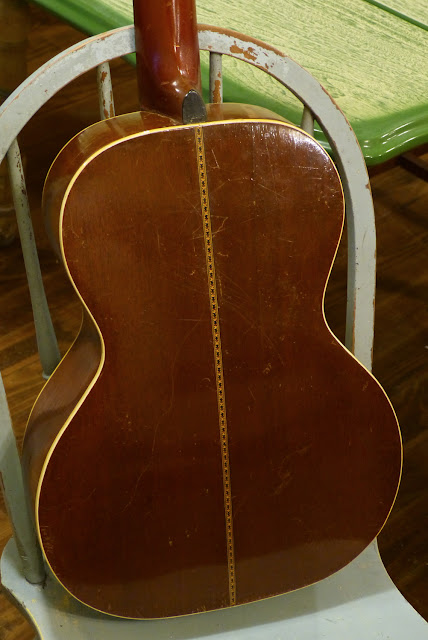1920s Oscar Schmidt-made Galiano Parlor Guitar
I've seen examples Galiano-labeled guitars made by just about all the "jobbers" -- Harmony, Kay, Regal, etc. -- but most are Oscar Schmidt products and a few were made by the higher-end "New York Italian Guild" luthiers which seem to have been gathered around Schmidt as a focal point. This one is almost at the quality level (and build style) of those but I honestly think it was made in the Schmidt factory itself as it has much more in common with fancy Sovereign-branded Schmidts than it does with the higher-end "Guild" Galianos.
This guitar was sent in via a customer for repair and it received a neck reset (glued and bolted due to a shallow dovetail angle at the sides of the joint), a couple replacement frets, a fret level/dress, some small bridge repair (I countersunk a tiny screw to keep a hairline crack in order) and a recut (for compensation) saddle slot, a brace reglue, new bone saddle, new ebony bridge pins, some minor hairline crack repairs to the back, and a good setup, of course. She's playing on-the-dot at 1/16" DGBE and 3/32" EA at the 12th fret. The owner likes nickel strings so it's strung with 50w-11s in nickel.
I like this 0-size box a lot as a fingerpicker, though as a flatpicker it works nicely, too, if you have a light touch. I find that the farther up the Schmidt-style food chain you go, the more these guitars sound comparable to ladder-braced Larson and Vega products -- that is, they're a bit more clear-toned and balanced and less woody/bluesy like the lower-market Stella and La Scala products made by Schmidt.
This one is solid spruce over solid mahogany and has a Brazilian rosewood bridge with a stained-maple fretboard. The neck is mahogany and has a medium-sized round profile and a 25" scale length.
The original, celluloid nut still survives.
Pearl dots are in the flat fretboard. This has a 1 3/4" nut width.
Don't you just love all that purfling and the rosette? It's gorgeous. The top has a lot of wear and tear and some long lines in the finish, but it's (thankfully) crack-free.
I filled the original straight saddle slot and then cut a new, compensated, drop-in saddle slot. The treble side of the bridge had an old hairline split in it which I shored-up with a tiny, countersunk screw. The pins are new, ebony ones, and the compensated saddle is a new bone one.
The back is also bound and has a nice, inlaid backstrip, too.
As you can see, the neck reset allowed for a good, tall saddle.
Someone glued the original endpin in at some point.


















Comments